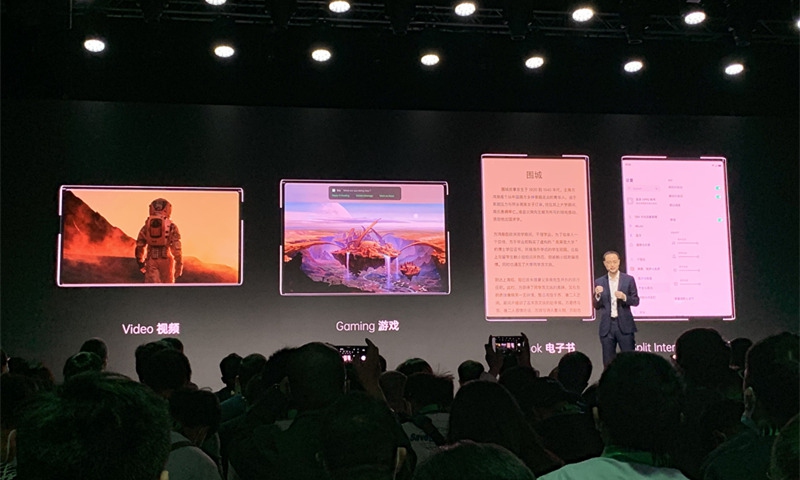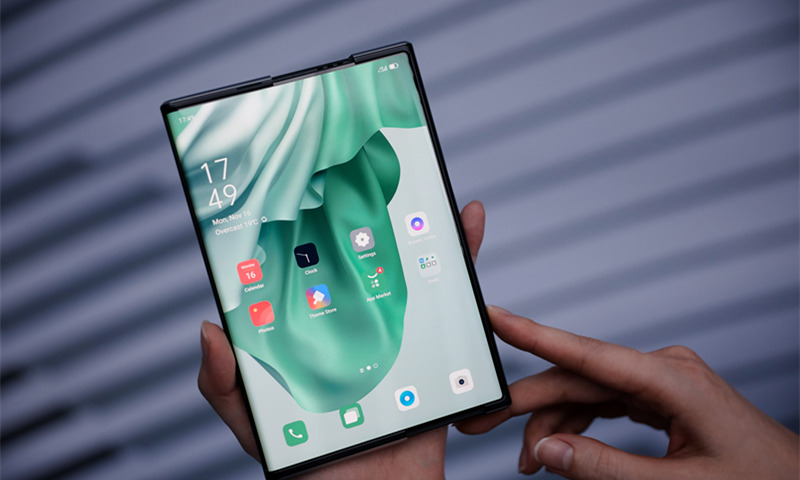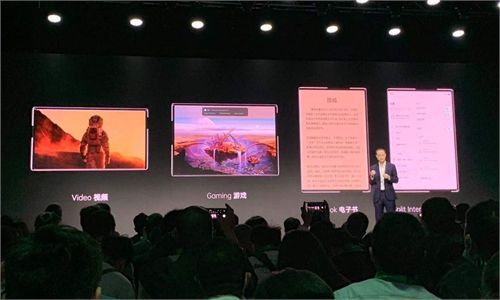SOURCE / INDUSTRIES
Global early starters are in a race to commercialize extendable smartphone

Oppo Inno Day 2020 in Shenzhen, South China's Guangdong Province in November Photo: Li Xuanmin/GT
After foldable smartphones and dual-screen phone-tablets, what is the next bandwagon that could lead to an industrial revolution?
With the launch of a rollable concept smartphone that is able to extend and retreat to give two form factors in a single device, Chinese smartphone maker Oppo wows the market with its unique answer to such question.
With a "continuously variable OLED display," the smartphone doesn't have a fixed display size and can be extended from 6.7 inches to 7.4 inches. Users can either push a side button twice or swipe up and down to make the phone change between different sizes, functioning similar to paper on a scroll. The software installed is also adaptable and could adjust for the aspect ratio on different screen sizes.

An Oppo handset with rollable screen Photo: Courtesy of OPPO
The handset features three of OPPO's proprietary technologies: a Roll Motor powertrain inside the body of the phone that powers the phone when changing size; a 2-in-1 Plate that provides support to the screen and prevent the screen from collapsing; and a Warp Track high-strength screen laminate that boosts durability.
The new gadget was launched at the Oppo Inno Day 2020 in Shenzhen, South China's Guangdong Province on Tuesday. The event is a yearly conference where Chinese tech firms show their latest innovation.
During the launch, Levin Liu, OPPO vice president and head of OPPO Research Institute, said that the smartphone display can achieve a zero-crease seamless screen, an issue that has been haunting foldable smartphone developers for a long time.
Liu stressed that the extendable phone will give users an optimal experience based on their actual need.
"If you're watching a video or playing a game, you may prefer a larger size in landscape orientation. If you're reading e-books, you may opt for other sizes in the portrait orientation. The rollable phone also allows you to perform multiple tasks. For example, you could play games in one screen and when messages pop up, you can reply to them in a separate screen," Liu said.
Jin Xiang, an Oppo hardware structure engineer, said in a group interview shortly after the release that the smartphone is now able to broaden and narrow over 100,000 times.
"If the smartphone is extended 50 times a day, it can be used for five and a half years, and if the rate is increased to 100 times a day, its life time is two to three years," Jin said, while stressing that as tests are ongoing, the 100,000 times will not likely be the "ceiling".
Smartphone for the future
Market demands for interactive flexible bigger screens have been growing in recent years as more and more information is now carried and transmitted through videos and other new media.
According to Liu, the Oppo X 2021 smartphone is Oppo's latest vision of a smartphone for the future, after global vendors have been in a rush to roll out foldable smartphones, afraid of being left behind in the competition. Oppo said earlier in a post on Twitter that the device will "usher in a new era for screens."
It is not clear when Oppo's new concept phone will come to the market. Liu said that the phone is still in concept stage, but he hopes to bring this technology to consumers "at the right time."
The launch, coming against the backdrop of US-led relentless crackdown on China's tech rise and white-hot global tech competition, makes Oppo among the first batch of global players to come up with a cutting-edged and revolutionary solution to a bigger screen.
"This is an encouraging sign. It shows that Chinese tech firms are climbing up the tech ladder to be world-leading players," Liu Dingding, a Beijing-based veteran analyst, told the Global Times over the weekend.
Liu, the OPPO vice president, told reporters in a group interview last week that the company hopes the concept rollable smartphone could set the direction and standard for the industry, and lead to more commitment on relevant research and development among upstream and downstream suppliers.
Ahead of Oppo, other Chinese and foreign companies including TCL and LG launched similar rollable devices this year. Analysts said that those smartphone makers are now in a race to commercialize the technology, and Chinese players could take the lead thanks to an early start and a complete electronic industrial chain that is able to adjust and react in a swift manner.
However, industry insiders all agreed that there are still a lot of technological challenges to overcome before the rollable product is mature enough to put on the market.
Some analysts the Global Times talked with showed concerns around the battery capacity of the rollable smartphone. "As the underpinning structure occupies a bulk of area in the body of the smartphone, it remains to be seen how developers balance the space of batteries and other main IC components with the supporting structure," an analyst told the Global Times on Thursday on condition of anonymity.
Liu, the analyst, predicted that the rollable deivce won't be an affordable "mainstream smartphone" in the short-term as the cost is extremely high and the technology is complicated and needs to be upgraded many times.
In October, LG's rollable signature OLED R TV hit the South Korea market - with a hefty price tag of $87,000.




